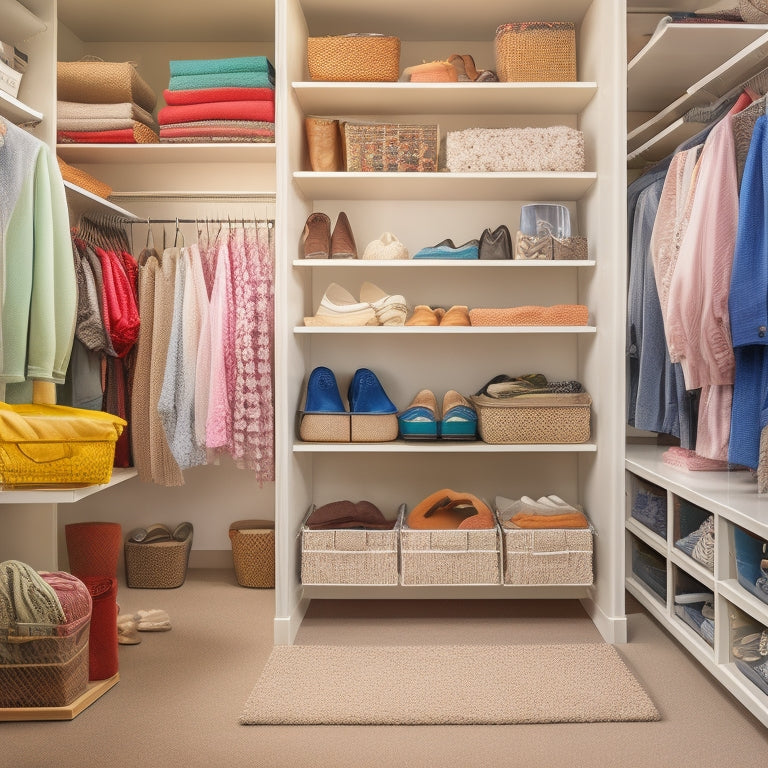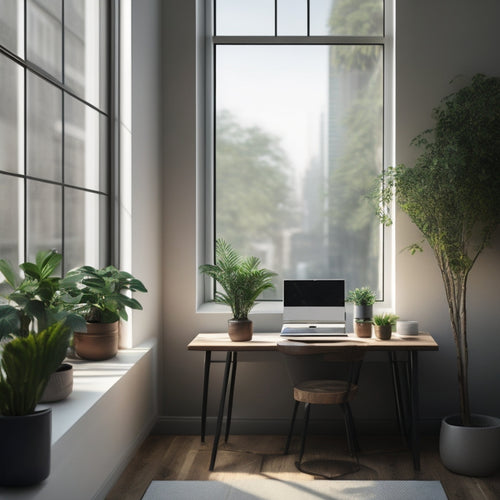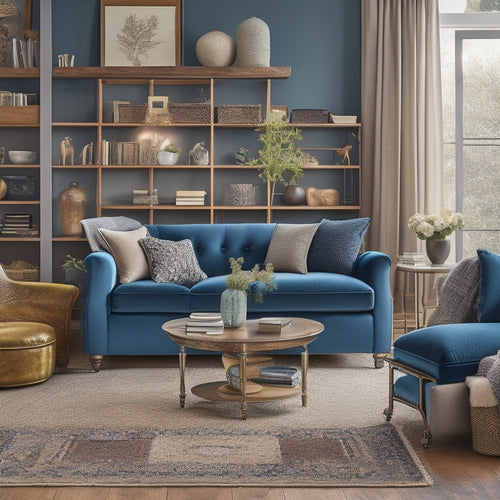
Boost Reach-In Closet Capacity With 3 Essential Tips
Share
You can boost your reach-in closet's storage capacity by implementing three essential strategies. First, optimize shelf space allocation by assigning prime real estate to your most-worn items and using shelf dividers to separate categories. Next, maximize vertical storage potential by utilizing stackable containers, installing ceiling hooks, and doubling hanging space. Finally, streamline your closet floor planning by grouping similar items together and creating distinct zones. By applying these tips, you'll increase storage capacity, reduce clutter, and make finding items easier. Now, discover how to fine-tune these strategies to create a tailored storage solution that meets your unique needs.
Key Takeaways
• Allocate shelf space based on frequency of use and item size to maximize storage capacity and accessibility.
• Utilize vertical storage potential with stackable containers, ceiling hooks, and double rods to reduce clutter and increase capacity.
• Create an efficient floor plan with a home for each item, grouped by type and logically arranged within each zone.
• Implement corner utilization strategies like carousel shelves or baskets to optimize often-wasted space.
• Use shelf dividers to separate item categories and create distinct zones, maintaining organization and preventing clutter buildup.
Optimize Shelf Space Allocation
To maximize your reach-in closet's storage potential, start by allocating shelf space according to the frequency of use and size of your items. This means reserving prime real estate for your most-worn clothes and accessories, while relegating less-frequently used items to higher or lower shelves.
Next, make the most of those pesky corners by implementing corner utilization strategies, such as carousel shelves or baskets, which allow you to access items easily without having to dig through clutter.
Additionally, consider using shelf dividers to separate categories of items, like tops from bottoms, or to create separate zones for different family members. These dividers will help maintain organization and prevent clutter from building up in the future.
Maximize Vertical Storage Potential
Maximize Vertical Storage Potential
By making the most of your reach-in closet's vertical space, you can greatly increase its storage capacity without sacrificing floor space. This is especially important if you have a smaller closet. Here are some practical ways to maximize your vertical storage potential:
| Storage Solution | Description | Benefits |
|---|---|---|
| Stackable Containers | Use containers that can be stacked on top of each other to store items like sweaters, blankets, or out-of-season clothing. | Saves floor space, keeps items organized, and makes the most of vertical space. |
| Ceiling Hooks | Install hooks that hang from the ceiling to store items like bikes, luggage, or infrequently used items. | Frees up floor space, keeps items out of the way, and adds storage capacity. |
| Double Rods | Install double rods to double your hanging space for clothes. | Increases storage capacity, reduces clutter, and makes it easier to find what you need. |
Streamline Closet Floor Planning
You'll want to create a floor plan that flows efficiently by assigning a home for each item, grouping similar items together, and leaving enough space to move around comfortably. This means dividing your closet into distinct zones, each dedicated to a specific type of item.
For instance, you might've a zone for tops, one for bottoms, and another for accessories. Within each zone, arrange items in a logical order, such as grouping similar items together or organizing by frequency of use.
When designing your floor pattern, consider a 'work triangle' layout, where you position frequently used items in a triangular formation to minimize walking distances. This layout also helps you navigate the space more efficiently.
Additionally, leave enough clearance between zones to prevent clutter from building up. Aim for about 12-18 inches of space between each zone.
Frequently Asked Questions
How Do I Prevent Clothes From Getting Wrinkled in a Reach-In Closet?
To prevent clothes from getting wrinkled, you're using clothing protectors like cloth bags or acid-free tissue to store delicate items, and mastering folding techniques like the KonMari fold to reduce creases.
What Type of Lighting Is Best for a Reach-In Closet?
Imagine exploring a dark forest; you need a guiding light to find your way. In your reach-in closet, you need a mix of ambient lighting for overall illumination and task lighting to spotlight specific areas, like shelves or hooks, to help you find what you need quickly.
Can I Install a Reach-In Closet in a Small Bedroom?
You can install a reach-in closet in a small bedroom by optimizing space planning and bedroom layout. Consider a slimmer closet system, and strategically place it to maximize floor space and create a sense of openness.
How Do I Keep Shoes Organized in a Reach-In Closet?
You'll keep shoes organized in your reach-in closet by using sturdy shoe racks that hold multiple pairs, and consider adding heel protectors to prevent scratching and damage, keeping your shoes looking their best.
Are Custom Reach-In Closets More Expensive Than Pre-Made Ones?
You'll find that custom reach-in closets are generally more expensive than pre-made ones due to higher material quality and design flexibility, allowing you to tailor the space to your specific needs and preferences.
Related Posts
-

Transform Your Space: 5 Online Courses to Help
Ready to transform your space from cluttered to calm? Start with mastering home organization fundamentals, like declu...
-

Top Digital Tools for Home Organization Success
To achieve home organization success, you'll want to tap into the power of digital tools. Start with decluttering and...
-

What Makes the Best DIY Storage Ottoman?
When constructing your ideal DIY storage ottoman, consider essential features like color, size, upholstery, and compl...


